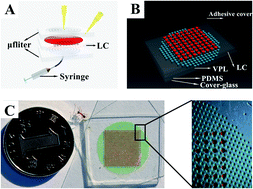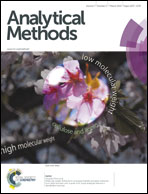A localized temporary negative pressure assisted microfluidic device for detecting keratin 19 in A549 lung carcinoma cells with digital PCR†
Abstract
Digital polymerase chain reaction (dPCR) has played a major role in biological research, especially by providing an accurate counting of single nucleic acid molecules. Here, we present a syringe filter-like microfluidic device to realize sample loading, encapsulation, moisturizing and running dPCR. The gas-permeability of polydimethylsiloxane (PDMS) is utilized for sample loading under negative pressure. The air in the chambers is evacuated to the negative pressure side, resulting in the sample solution entering into the chambers. We also add a vaporproof-layer (VPL) in the chip to moisturize or restrain evaporation caused by the gas-permeability of PDMS under thermal cycling. Digital PCR is applied to test keratin 19 on this microdevice with 650 chambers, each having a volume of 6.28 nL, using the cDNA from the A549 cell line. The results exhibit linear regression under five dilution concentrations, thus demonstrating the robustness of the dPCR chip. This device is easy to be fabricated without multiple overlay exposures or high alignment precision, and should prove to be an effective tool for biological research.

- This article is part of the themed collection: Microfluidics Research 2015-2016

 Please wait while we load your content...
Please wait while we load your content...